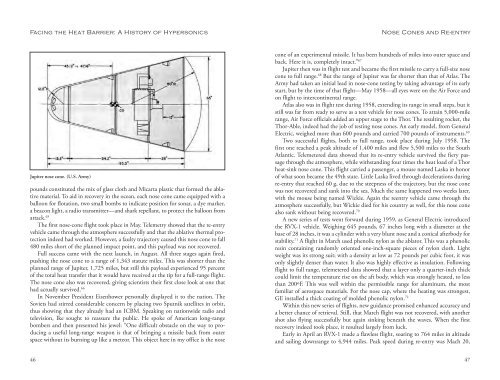Facing the Heat Barrier - NASA's History Office
Facing the Heat Barrier - NASA's History Office
Facing the Heat Barrier - NASA's History Office
Create successful ePaper yourself
Turn your PDF publications into a flip-book with our unique Google optimized e-Paper software.
<strong>Facing</strong> <strong>the</strong> <strong>Heat</strong> <strong>Barrier</strong>: A <strong>History</strong> of Hypersonics<br />
Jupiter nose cone. (U.S. Army)<br />
pounds constituted <strong>the</strong> mix of glass cloth and Micarta plastic that formed <strong>the</strong> ablative<br />
material. To aid in recovery in <strong>the</strong> ocean, each nose cone came equipped with a<br />
balloon for flotation, two small bombs to indicate position for sonar, a dye marker,<br />
a beacon light, a radio transmitter—and shark repellant, to protect <strong>the</strong> balloon from<br />
attack. 65<br />
The first nose-cone flight took place in May. Telemetry showed that <strong>the</strong> re-entry<br />
vehicle came through <strong>the</strong> atmosphere successfully and that <strong>the</strong> ablative <strong>the</strong>rmal protection<br />
indeed had worked. However, a faulty trajectory caused this nose cone to fall<br />
480 miles short of <strong>the</strong> planned impact point, and this payload was not recovered.<br />
Full success came with <strong>the</strong> next launch, in August. All three stages again fired,<br />
pushing <strong>the</strong> nose cone to a range of 1,343 statute miles. This was shorter than <strong>the</strong><br />
planned range of Jupiter, 1,725 miles, but still this payload experienced 95 percent<br />
of <strong>the</strong> total heat transfer that it would have received at <strong>the</strong> tip for a full-range flight.<br />
The nose cone also was recovered, giving scientists <strong>the</strong>ir first close look at one that<br />
had actually survived. 66<br />
In November President Eisenhower personally displayed it to <strong>the</strong> nation. The<br />
Soviets had stirred considerable concern by placing two Sputnik satellites in orbit,<br />
thus showing that <strong>the</strong>y already had an ICBM. Speaking on nationwide radio and<br />
television, Ike sought to reassure <strong>the</strong> public. He spoke of American long-range<br />
bombers and <strong>the</strong>n presented his jewel: “One difficult obstacle on <strong>the</strong> way to producing<br />
a useful long-range weapon is that of bringing a missile back from outer<br />
space without its burning up like a meteor. This object here in my office is <strong>the</strong> nose<br />
46<br />
Nose Cones and Re-entry<br />
cone of an experimental missile. It has been hundreds of miles into outer space and<br />
back. Here it is, completely intact.” 67<br />
Jupiter <strong>the</strong>n was in flight test and became <strong>the</strong> first missile to carry a full-size nose<br />
cone to full range. 68 But <strong>the</strong> range of Jupiter was far shorter than that of Atlas. The<br />
Army had taken an initial lead in nose-cone testing by taking advantage of its early<br />
start, but by <strong>the</strong> time of that flight—May 1958—all eyes were on <strong>the</strong> Air Force and<br />
on flight to intercontinental range.<br />
Atlas also was in flight test during 1958, extending its range in small steps, but it<br />
still was far from ready to serve as a test vehicle for nose cones. To attain 5,000-mile<br />
range, Air Force officials added an upper stage to <strong>the</strong> Thor. The resulting rocket, <strong>the</strong><br />
Thor-Able, indeed had <strong>the</strong> job of testing nose cones. An early model, from General<br />
Electric, weighed more than 600 pounds and carried 700 pounds of instruments. 69<br />
Two successful flights, both to full range, took place during July 1958. The<br />
first one reached a peak altitude of 1,400 miles and flew 5,500 miles to <strong>the</strong> South<br />
Atlantic. Telemetered data showed that its re-entry vehicle survived <strong>the</strong> fiery passage<br />
through <strong>the</strong> atmosphere, while withstanding four times <strong>the</strong> heat load of a Thor<br />
heat-sink nose cone. This flight carried a passenger, a mouse named Laska in honor<br />
of what soon became <strong>the</strong> 49th state. Little Laska lived through decelerations during<br />
re-entry that reached 60 g, due to <strong>the</strong> steepness of <strong>the</strong> trajectory, but <strong>the</strong> nose cone<br />
was not recovered and sank into <strong>the</strong> sea. Much <strong>the</strong> same happened two weeks later,<br />
with <strong>the</strong> mouse being named Wickie. Again <strong>the</strong> reentry vehicle came through <strong>the</strong><br />
atmosphere successfully, but Wickie died for his country as well, for this nose cone<br />
also sank without being recovered. 70<br />
A new series of tests went forward during 1959, as General Electric introduced<br />
<strong>the</strong> RVX-1 vehicle. Weighing 645 pounds, 67 inches long with a diameter at <strong>the</strong><br />
base of 28 inches, it was a cylinder with a very blunt nose and a conical afterbody for<br />
stability. 71 A flight in March used phenolic nylon as <strong>the</strong> ablator. This was a phenolic<br />
resin containing randomly oriented one-inch-square pieces of nylon cloth. Light<br />
weight was its strong suit; with a density as low as 72 pounds per cubic foot, it was<br />
only slightly denser than water. It also was highly effective as insulation. Following<br />
flight to full range, telemetered data showed that a layer only a quarter-inch thick<br />
could limit <strong>the</strong> temperature rise on <strong>the</strong> aft body, which was strongly heated, to less<br />
than 200ºF. This was well within <strong>the</strong> permissible range for aluminum, <strong>the</strong> most<br />
familiar of aerospace materials. For <strong>the</strong> nose cap, where <strong>the</strong> heating was strongest,<br />
GE installed a thick coating of molded phenolic nylon. 72<br />
Within this new series of flights, new guidance promised enhanced accuracy and<br />
a better chance of retrieval. Still, that March flight was not recovered, with ano<strong>the</strong>r<br />
shot also flying successfully but again sinking beneath <strong>the</strong> waves. When <strong>the</strong> first<br />
recovery indeed took place, it resulted largely from luck.<br />
Early in April an RVX-1 made a flawless flight, soaring to 764 miles in altitude<br />
and sailing downrange to 4,944 miles. Peak speed during re-entry was Mach 20,<br />
47
















